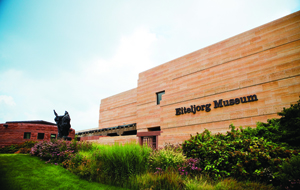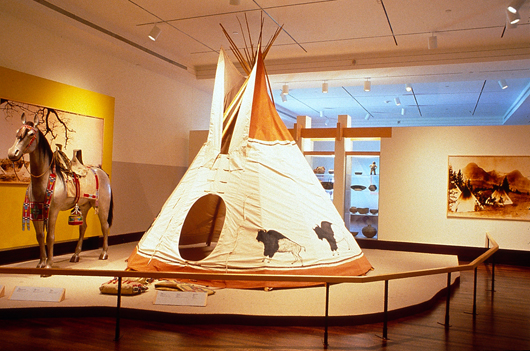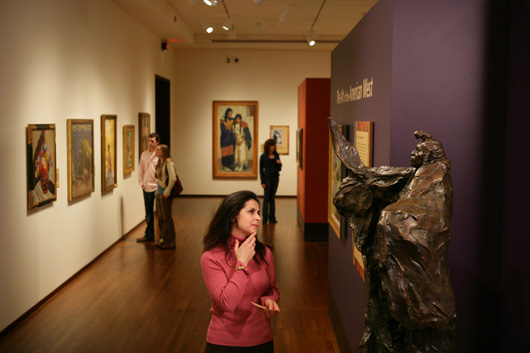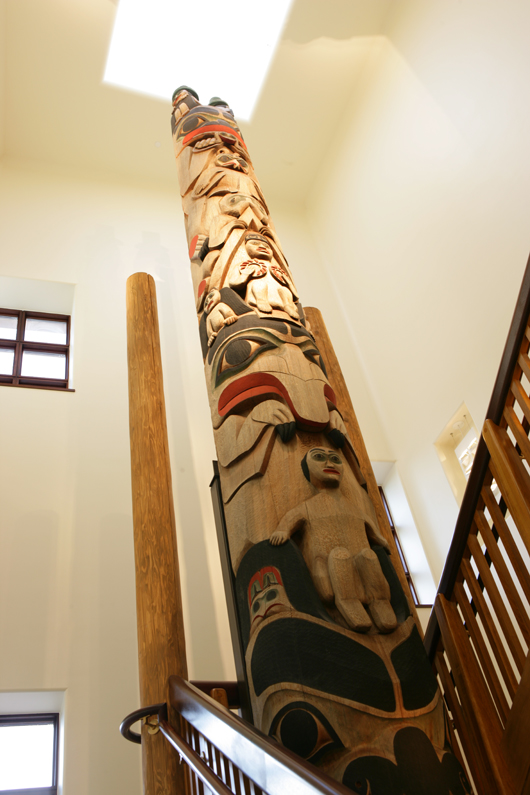
INDIANAPOLIS (AP) – It still looks like the Old West, a stately, adobe-ish structure that’d fit in on a John Ford/John Wayne set, but the Eiteljorg Museum of American Indians and Western Art lately has been living in the moment.
Saturday, for example, the museum screened Two Spirits, a documentary about the murder of a transgendered Navajo teenager. And over the last three years, visitors ogled stylized guns, motorcycles, and guitars, all symbols of the American west, museum officials say.
These exhibits and others have packed the house and changed the museum’s culture. After two decades of being stuck at 100,000-visitors-a-year, in 2010 the Eiteljorg jumped to 140,000, and has stayed there. It’s on track to clear $500,000 in ticket sales this year, three times what it brought in a little more than a decade ago (and a chunk when you consider the museum’s annual budget is just $7 million).
Museums and other cultural organizations, which rely heavily on charitable donations from wealthy people and corporations, have scrambled to appeal to broader audience since the 2008 financial meltdown led to shrinking donations and endowments. The Indianapolis Museum of Art’s director has talked about hosting a car show—and he’s behind the curve: In Nashville the Frist Center for the Visual Arts’ “Sensuous Steel: Art Deco Automobiles” closed two weeks ago, and drew 115,000 visitors (the Indianapolis Museum of Art would be happy to coax 80,000 to its giant Matisse show opening next month).
The Eiteljorg’s turnabout, which interestingly did not involve bringing in new leadership, started during the depths of the recession, The Indianapolis Star reported (http://indy.st/16vceBw ).
“What began the conversation was how awful the financial climate was,” said John Vanausdall, the museum’s CEO, who by then had been running the museum a decade and a half. “We looked ahead and thought, ‘Things don’t look good for the economy, and it’s time for the Eiteljorg to look for a new strategy.’ We interviewed visitors and potential visitors and concluded (the museum) had great awareness but could use better visitation.”
“We started brainstorming,” said Chris Katterjohn, a board member since the mid-1990s who recently wrapped up a two-year stint as board chair, “and we came up with a strategy we called ‘the unexpected West.’ When most people thought of the Eiteljorg they were thinking of Indian pottery, Western paintings, and we understand the audience for that niche is somewhat limited. So we came up with topics we thought would be related to the west that would attract different audiences.”
The new strategy debuted in 2011 with the exhibit “Red/Black,” which focused on the shared history of African-Americans and American Indians. It drew an astounding 61,000 visitors, nearly twice as many as the museum’s previous record-holder, a 2001 exhibit of iconic photographs of the west by the legendary Ansel Adams.
Next came “Steel Ponies,” the motorcycles, which topped “Red/Black,” and after the motorcycles came the guitars, which turned out to be the most popular show in the museum’s 24-year history, with 63,000 visits.
In the middle of all this came “Jingle Rails,” a giant toy train set that since 2010 has been displayed at Christmas. The train makes its way westward from a tiny Indianapolis past miniatures of attractions like the Grand Canyon, Mount Rushmore and so forth. Since its debut, Jingle Rails has averaged 46,000 visits, or nearly five times as many visits as the western art stand-by Georgia O’Keefe drew in 2005.
In O’Keefe’s defense (or maybe in the museum-going public’s defense), the Eiteljorg doubled its spending on marketing.
In 1998 the Guggenheim museum in New York drew record crowds with “The Art of the Motorcycle,” but it also drew fire. “The Guggenheim might bring in more people if they offered rides from Coney Island,” sniffed one private art dealer to The New York Times.
Vanausdall, however, said he has fielded not a single such complaint. “We are like a new museum,” he said, “but we are sticking to our mission. Our mission is about the arts and the history of the American West and native people. And things like the motorcycle are all about the social history of the American west. Same thing for the guitar—the development of the guitar is largely a Western story.”
And, Vanausdall said, people who are drawn to the special exhibits tend to stick around a while and linger in the permanent galleries. “These are people who haven’t been here before,” he said. “It’s amazing. People say, ‘Wow.’”
Next up: a series of some three dozen photographs shot by Los Angeles-based Blake Little documenting the goings on of the International Gay Rodeo Association. The exhibit opens Jan. 18, 2014.
More Ansel Adams photos go on display March 1.
___
Information from: The Indianapolis Star, http://www.indystar.com
Copyright 2013 Associated Press. All rights reserved. This material may not be published, broadcast, rewritten, or redistributed.
AP-WF-09-21-13 1958GMT
ADDITIONAL IMAGES OF NOTE






